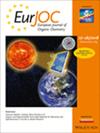Point‐to‐axis optical activity induction in extended, sterically congested chromophoric systems
IF 2.5
3区 化学
Q2 CHEMISTRY, ORGANIC
引用次数: 0
Abstract
The readily available, modular and electronic circular dichroism (ECD)‐silent derivatives of terephthalaldehyde (the probes) have exhibited an induced optical activity upon condensation with chiral primary amines. The central unit of the probe serves as an amine binder by forming imine bonds and is flanked by two extended chromophoric units (“the wings”). Modification of the wings by diphenylamine or carbazole units affects the sterical and spectroscopic properties of the probes. An increase in sterical congestion within the probe core resulted in a change in the mechanism of optical activity induction. In the more congested systems, the point‐to‐axial chirality transmission from the chiral amine (the inducer) to the chromophoric system led to the adaptation of helical conformation by “the wings” and the appearance of non‐zero Cotton effects (CEs) in the low‐energy part of the ECD spectrum. However, the sterically congested probes were sensitive to the chirality of the inducers but relatively indifferent to the differences in their structure. Thus, the chirality of the inducers triggers conformational change towards the thermodynamically preferred conformational diastereoisomer due to the probe's —1 ‐ +1 operation scheme.扩展的、立体拥挤的显色系统中点对轴旋光性的诱导
易于获得的,模块化和电子圆二色性(ECD)沉默的对苯二甲酸衍生物(探针)在与手性伯胺缩合时表现出诱导的光学活性。探针的中心单元通过形成亚胺键作为胺粘合剂,并由两个扩展的显色单元(“翅膀”)组成。二苯胺或咔唑对探针的修饰会影响探针的空间和光谱性能。探针芯内空间阻塞的增加导致了光学活性诱导机制的变化。在更密集的体系中,从手性胺(诱导剂)到显色体系的点向轴手性传递导致了“翅膀”对螺旋构象的适应,并在ECD谱的低能部分出现了非零棉花效应(CEs)。然而,空间阻塞探针对诱导剂的手性敏感,而对诱导剂的结构差异相对漠不关心。因此,由于探针的-1‐+1操作方案,诱导剂的手性触发了向热力学上首选的构象非对映异构体的构象变化。
本文章由计算机程序翻译,如有差异,请以英文原文为准。
求助全文
约1分钟内获得全文
求助全文
来源期刊
CiteScore
5.40
自引率
3.60%
发文量
752
审稿时长
1 months
期刊介绍:
The European Journal of Organic Chemistry (2019 ISI Impact Factor 2.889) publishes Full Papers, Communications, and Minireviews from the entire spectrum of synthetic organic, bioorganic and physical-organic chemistry. It is published on behalf of Chemistry Europe, an association of 16 European chemical societies.
The following journals have been merged to form two leading journals, the European Journal of Organic Chemistry and the European Journal of Inorganic Chemistry:
Liebigs Annalen
Bulletin des Sociétés Chimiques Belges
Bulletin de la Société Chimique de France
Gazzetta Chimica Italiana
Recueil des Travaux Chimiques des Pays-Bas
Anales de Química
Chimika Chronika
Revista Portuguesa de Química
ACH—Models in Chemistry
Polish Journal of Chemistry.

 求助内容:
求助内容: 应助结果提醒方式:
应助结果提醒方式:


